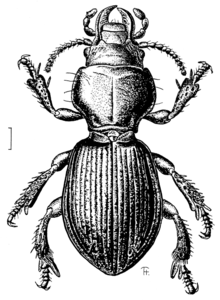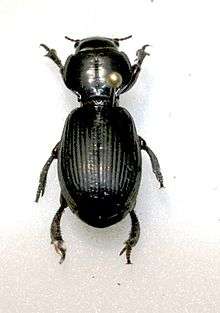Brullea
Brullea antarctica is a carnivorous carabid beetle, the only species in its genus,[1] that burrows in sand above the high tide mark on New Zealand beaches. Both the genus and species were first described by Francis de Laporte de Castelnau in 1867.
| Brullea antarctica | |
|---|---|
 | |
| Illustration by Tony Harris | |
| Scientific classification | |
| Kingdom: | |
| Phylum: | |
| Class: | |
| Order: | |
| Suborder: | |
| Family: | |
| Genus: | Brullea Castelnau, 1867 |
| Species: | B. antarctica |
| Binomial name | |
| Brullea antarctica Castelnau, 1867 | |
Description
Brullea antarctica is large (25 mm), glabrous reddish brown to black with a distinct "waist" or narrowing between thorax and abdomen, like the related genus Mecodema.[2] Indeed, recent DNA analysis places it within that genus, a sister group to Mecodema curvidens; its distinctive differences in body shape may be adaptations to burrowing in sand.[3]
Brullea's legs are well-adapted for digging in sand with greatly expanded coxa, femur and tibia: all tibia are greatly expanded at their distal ends, and the middle and hind pairs are also strongly curved.[4] Brullea has short antennae, large curved mandibles, and a rather boxy shape in contrast to the longer more elegant Mecodema. Its larval form was unknown for some time, and was first described in 1978.[5][6]
Distribution

Brullea is found in the supralittoral or splash zone of sandy beaches around the New Zealand coast, underneath logs or stones, hiding in the sand during the day and emerging at night to feed.[7][8] It was described by George Hudson as "usually rare",[7] but is a secretive burrowing beetle, and occasionally is discovered in reasonable numbers.[9] It was rediscovered by schoolchildren on the Whanganui coast in 2006 after not being recorded for many years.[10]
Brullea antarctica has been recorded being heavily preyed on by katipō spiders,[9] and it may be threatened by the introduced South African spider Steatoda capensis, either as a predator or competitor.[11]
References
| Wikispecies has information related to Brullea antarctica |
| Wikimedia Commons has media related to Category:Brullea antarctica. |
- "Brullea Castelnau, 1867". Carabidae of the World. 2011. Archived from the original on 3 March 2016. Retrieved 24 Jun 2011.
- Britton, Everard B. (1949). "The Carabidae (Coleoptera) of New Zealand: Part III—A Revision of the Tribe Broscini". Transactions of the Royal Society of New Zealand. 77 (4): 533–581. Retrieved 14 October 2016.
- Goldberg, Julia; Knapp, Michael; Emberson, Rowan M.; Townsend, J. Ian; Trewick, Steven A. (2014). "Species Radiation of Carabid Beetles (Broscini: Mecodema) in New Zealand". PLoS ONE. 9 (1): e86185. doi:10.1371/journal.pone.0086185. ISSN 1932-6203. PMC 3900486. PMID 24465949.
- Roig-Juñent, Sergio (2000). "The subtribes and genera of the tribe Broscini (Coleoptera: Carabidae): cladistic analysis, taxonomic treatment, and biogeographical considerations". Bulletin of the American Museum of Natural History. 255: 1. doi:10.1206/0003-0090(2000)255<0001:tsagot>2.0.co;2.
- Harris, A. C. (1978). "The larva of Brullea antarctica (Coleoptera: Carabidae: Broscinae)". New Zealand Entomologist. 6 (4): 401–405. doi:10.1080/00779962.1978.9722304.
- Harris, A. C. (1980). "The larva of Brullea antarctica (Coleoptera: Carabidae: Broscinae): note". New Zealand Entomologist. 7 (2): 174–175. doi:10.1080/00779962.1980.9722369.
- Hudson, George Vernon (1934). New Zealand Beetles and Their Larvae. Wellington: Ferguson and Osborn. pp. 33–34.
- Brooks, Paul (27 April 2016). "Collect beetles for museum study". Wanganui Midweek. Retrieved 2 May 2016.
- Bull, R. M. (1959). "A note on the occurrence of Brullea antarctica Castelnau (Coleoptera: Carabidae) at Otaki Beach". New Zealand Entomologist. 2 (4): 9. doi:10.1080/00779962.1959.9722773.
- Beautrais, Margie (13 February 2012). "Conservation: Seaweek tribute to national treasure". Wanganui Chronicle. Retrieved 7 March 2016.
- Gardner-Gee, Robin; Graham, Sharen; Griffiths, Richard; Habgood, Melinda; Heiss Dunlop, Shelley; Lindsay, Helen (2007). Motuora Native Species Restoration Plan (PDF). Auckland: Department of Conservation & Motuora Restoration Society. p. 89.